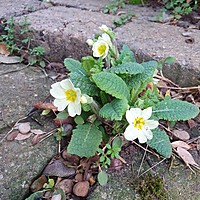8 March 2024
Primroses
I can’t imagine a Spring without primroses. As far back as the Middle Ages they were clearly much loved and praised. Both primroses and cowslips have been used medicinally from way back. Leonardo da Vinci reckoned they were good for stones in the bladder but I’m not suggesting you try that!
We lived on the Isle of Wight for a few years until we moved to Charnwood in 1987, and I brought a few primrose plants with me. These are of the pale creamy yellow kind, not the more vivid colours frequently on sale now; I know they are all loved by someone and I have indulged in a little multi coloured primrose spree myself at times. But in truth I feel they are not the real thing.
Primroses seem to prefer a little shade and soil that does not dry out, so a woodland kind of setting is perfect. They have come through this awful wet winter here as well as anything in the garden. A little leaf mould as a gentle mulch is good if you have it, that will help them to thrive and if they are happy, they will seed around.
The snowdrops have been wonderful this year. They don’t seem to have suffered by the relentless winter deluges. Now is a good time to split up your clumps and spread them around the garden, so called ‘planting in the green’. Many plants can be split up and replanted now: hardy geraniums, day lilies, phlox, herbs such as marjoram – to name a few. Anything that flowers a bit later in the year. If they are in flower in early Spring they are best split in the Autumn. Pick the more vigorous new growth at the edge of the plant and remember to replenish the soil with a little compost and give them a good water after planting to give them a good start. If the centre of the clump is woody, discard it.
Your trees and shrubs, including fruit trees will also benefit from a good mulch of compost at this time of year. This will conserve water, improve the soil structure and keep the weeds down.
Don’t forget the wildlife that share our outdoor space, it is their home too. I came across some research about wood lice recently. Did you know that they are not insects, but crustaceans, making them more like a prawn than a beetle? They do real good in your compost heap, helping to get it all nice and crumbly. So these little creatures are more friend than foe. We all know by now the benefit of making your garden a safe, happy place for wildlife so remember, don’t be too tidy! And be careful if you are cutting hedges and pruning shrubs, hedge trimmers can have disastrous consequences for our birds.
Once the daffodils have finished flowering deadhead them if you can, give them a handful of plant food and don’t tie them up into bundles. That way they are more likely to flower well for you next year. If they have stopped flowering it may mean they are a bit tired and malnourished. Dig them up and replant them good and deep and spaced out a bit with a little fresh compost. They may take a year to settle down but then you should have your hard work rewarded by a lovely show in Spring 2025.
